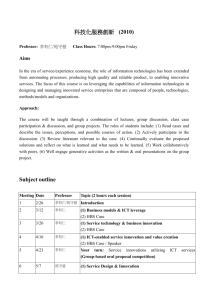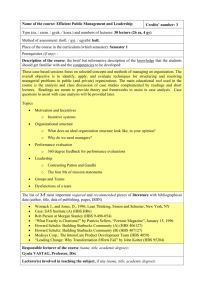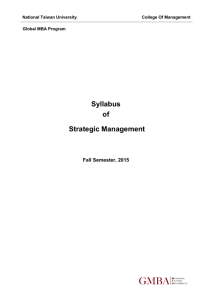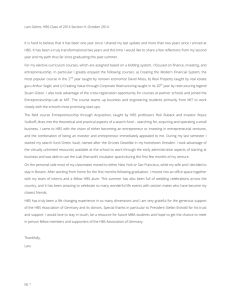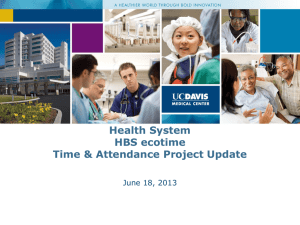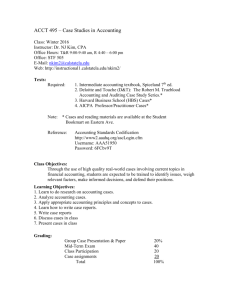Document 11070063
advertisement
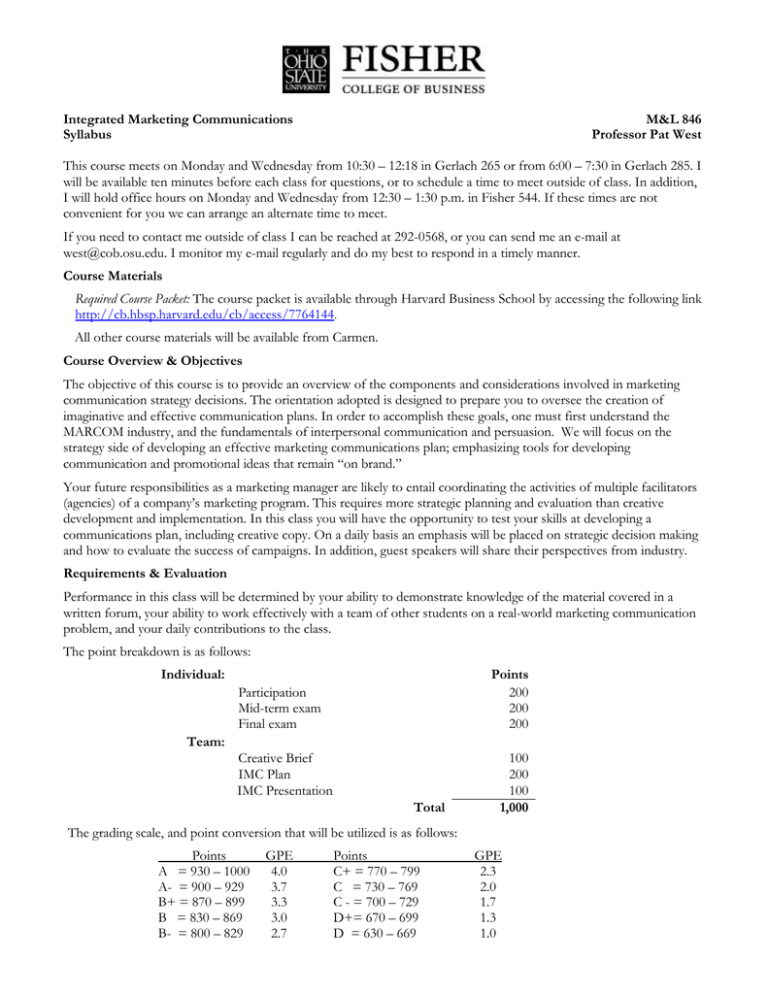
Integrated Marketing Communications Syllabus M&L 846 Professor Pat West This course meets on Monday and Wednesday from 10:30 – 12:18 in Gerlach 265 or from 6:00 – 7:30 in Gerlach 285. I will be available ten minutes before each class for questions, or to schedule a time to meet outside of class. In addition, I will hold office hours on Monday and Wednesday from 12:30 – 1:30 p.m. in Fisher 544. If these times are not convenient for you we can arrange an alternate time to meet. If you need to contact me outside of class I can be reached at 292-0568, or you can send me an e-mail at west@cob.osu.edu. I monitor my e-mail regularly and do my best to respond in a timely manner. Course Materials Required Course Packet: The course packet is available through Harvard Business School by accessing the following link http://cb.hbsp.harvard.edu/cb/access/7764144. All other course materials will be available from Carmen. Course Overview & Objectives The objective of this course is to provide an overview of the components and considerations involved in marketing communication strategy decisions. The orientation adopted is designed to prepare you to oversee the creation of imaginative and effective communication plans. In order to accomplish these goals, one must first understand the MARCOM industry, and the fundamentals of interpersonal communication and persuasion. We will focus on the strategy side of developing an effective marketing communications plan; emphasizing tools for developing communication and promotional ideas that remain “on brand.” Your future responsibilities as a marketing manager are likely to entail coordinating the activities of multiple facilitators (agencies) of a company’s marketing program. This requires more strategic planning and evaluation than creative development and implementation. In this class you will have the opportunity to test your skills at developing a communications plan, including creative copy. On a daily basis an emphasis will be placed on strategic decision making and how to evaluate the success of campaigns. In addition, guest speakers will share their perspectives from industry. Requirements & Evaluation Performance in this class will be determined by your ability to demonstrate knowledge of the material covered in a written forum, your ability to work effectively with a team of other students on a real-world marketing communication problem, and your daily contributions to the class. The point breakdown is as follows: Individual: Points 200 200 200 Participation Mid-term exam Final exam Team: Creative Brief IMC Plan IMC Presentation Total 100 200 100 1,000 The grading scale, and point conversion that will be utilized is as follows: Points A = 930 – 1000 A- = 900 – 929 B+ = 870 – 899 B = 830 – 869 B- = 800 – 829 GPE 4.0 3.7 3.3 3.0 2.7 Points C+ = 770 – 799 C = 730 – 769 C - = 700 – 729 D+= 670 – 699 D = 630 – 669 GPE 2.3 2.0 1.7 1.3 1.0 M & L 846 Syllabus - 2 The Fisher College of Business grading policy specifies that the average grade point equivalent for an elective class should not exceed 3.6. This implies only about one-half of students in an elective course can receive an A or A-. According to the MBA Student Handbook, academic misconduct is defined as any activity that compromises the academic integrity of the institution or subverts the educational process. Examples of academic misconduct include, but are not limited to: Violation of course rules contained in this course syllabus or other information provided. Providing or receiving information during examinations; or providing or using unauthorized assistance on assignments. Submitting the same or similar work for credit in more than one class Alteration of grades or marks in an effort to change the earned grade or credit. Failure to report incidents of academic misconduct. Plagiarism, which is intellectual theft, will not be tolerated. Any use of another author’s research, ideas, or language without proper attribution may be considered plagiarism. If an instance of academic misconduct is observed or reported, the University Committee on Academic Misconduct will be notified in accordance with The Ohio State University Code of Student Conduct. Any instance of academic misconduct will result in a failing grade in this course. Mid-term and Final Exams. During week 6 and week 11 you will be asked to demonstrate your knowledge of the assigned reading materials, constructs and issues discussed in class. The exams will be taken in class and the format will entail responding to essay questions. You will have access to your notes, articles, a laptop computer, and a calculator. On the class website you will find daily “thought questions” for you to consider before coming to class. These offer a great way to study for the exams. The in-class and on-line discussions are likely to generate additional fodder for exam questions. Make-up exams are not permitted without prior consent. Team Project The purpose of this assignment is to provide experience in the process of developing the elements of an integrated marketing communications plan for a product/service/organization of your choosing. You and your teammates will work on this project throughout the quarter in two stages corresponding to the course content. A workbook is provided on the website to walk you through the necessary steps needed to accomplish your objective -- developing an effective marketing communications plan. The first stage of the process entails developing a written brief for potential agency partners. The purpose of this document is to provide your agency a platform for creative development that allows your company to accomplish its strategic objectives while staying “on-brand” with your message. There is no page limit for this document. Your goal should be to present the material in a comprehensive yet concise manner. You will utilize the skills you developed in previous marketing classes as well as this class to: (1) Perform a situation analysis (remember the 5Cs and SWOT?); (2) construct a marketing strategy (STP) that takes into consideration the positioning and current communication campaign for your product/service; and (3) develop a clear communication strategy for the creative team to design and implement. The second stage is the development of an integrated marketing communications plan that includes: (1) a “signature creative piece” that will specify the brand message and means of delivery to be used as the platform for the campaign; (2) a discussion of how supporting MARCOM functions will be utilized to maximize effectiveness; (3) rationale supporting the proposed creative development; (4) a proposed media plan that includes a timeline for the launch of the campaign and its specific elements; (5) an accounting for how the budget will be allocated among the selected MARCOM functions; (6) a discussion of anticipated results and means for evaluating the proposed campaign. M & L 846 Syllabus - 3 Selection of Your Product/Service/Organization. Each team will have the freedom to select their product, service, or organization, however, two factors should guide this selection. First, the team should select a firm that could improve its market position by changing its marketing communications strategy and/or execution. In other words, market leaders should be avoided because they offer less opportunity for your team to demonstrate their talents. Second, it is very important that you have access to the background information necessary for developing a strong brief. Background materials should be sought from your client, or in some instances recent HBR cases can be useful in providing company specific or industry information. If you are planning to work with a local organization, be sure they are willing to share necessary information with your team. Presentations. Teams will present their work at the end of the quarter to the entire class and hopefully with the client present. Each team will have up to 20 minutes (15 minutes for your presentation followed by 5 minutes for questions). Here are some guidelines for the presentations… 1) Don’t feel obliged to have all team members present. There are many ways for others to contribute, such as preparing the materials and editing the talk. 2) Be careful to budget your time wisely. Rehearse the presentation several times to make sure that you have the “right” amount of material to cover (not too much or too little). Leaving ample time for Q & A is important. 3) Establish eye contact with as much of the audience as possible! – Know your material well enough that you can engage your audience and not rely on note cards. The key here is practice! 4) This is meant to be a “professional presentation.” Personality and warmth are important characteristics of effective speakers. Humor can be an effective way to establish rapport, however if it is not “delivered well” it can backfire. Write what you plan to say in advance and carefully select your words to avoid generalizing, vague references, and offensive or derogating comments. 5) Professional, but not interview ready attire is appropriate. People in the advertising industry are known for their “artsy/trendy” attire, which is more casual than traditional business dress. However, you also know that appearances matter and in this case it signals credibility to your audience. Be sure to discuss attire with your teammates to achieve a consistent “look.” 6) Be sure to prepare a handout for your audience. The handout should include the slides you present and details such as data and sources. The trend for presenting a creative plan is to wait and distribute your slides after the talk. This holds the audience attention, lets you control the flow, and allows for the big “reveal” of the creative work. You are welcome to either present your slides upfront, or at the end of your presentation. 7) I am sure that you already know what to watch out for with in preparing your slides. Here is a checklist: a) Are we trying to cram too much material on a slide? If you think the audience might have difficulty reading the slide, or the information will distract, create a handout to convey the information. Spreadsheets are rarely a good idea unless the information can be quickly digested. Graphs and figures are much easier for the audience to process and therefore more effective communication. b) Have you selected a font that will be easy to read and will not pose problems with loading on the classroom computer? It is a good idea to test your slides on the computer you will be presenting them on to make sure there are no surprises during the presentation. When selecting a color palate, be sure that your slides will be easily readable from the projector. Ask yourself; is this font size big enough for Professor West to read? If it is then everyone in the room should be able to follow you. c) Don’t try to cover too much material, as a rule of thumb a twenty minute presentation should have no more than about 15 - 20 slides. You should not be standing up and reading from your slides, rather use them as “talking points” and fill in the content as you go. As a counterpoint to this advice, be sure that your slides are designed to trigger the major points (take-a-ways) from the talk when reviewing them in retrospect. Evaluating Performance. Team members will be evaluated based on the two written reports, the presentation, and their contribution to the team effort. A peer review process will be used to evaluate individual performance. Each of you will evaluate the contribution of your team members at the conclusion of each stage of the project. These evaluations will be used in determining team member’s project grades and class participation. Each member will receive a project grade proportionate to their contribution (as assessed by other team members). For example, if three members of a group feel that the fourth member only contributed 10% of the workload on a paper that received a grade of 92/100 then the grade assignments would be computed as follows. The contributing group members would each receive a score of 92, but the noncontributing individual would receive a score of (.25 + .25 + .25 + .10) x 92 = 78.2. M & L 846 Syllabus - 4 Working Together Effectively. Creating an effective marketing communication plan requires working with multiple parties and acting as a liaison for your company. We will attempt to recreate this experience with the team project. The single greatest cause of disappointing team projects is the inability to work together effectively. The most important ways to prevent this are: 1) Pick meetings times that are convenient to all members of the team. It helps to schedule a weekly meeting time upfront for the quarter. Also try to be as accommodating as possible to other team members' schedules. 2) Always have a team member take comprehensive notes of your meetings so it is clear what decisions the team has agreed to and who has taken responsibility for different parts of the project. Your project workbook will help here. Make sure that someone on the team is completing the necessary information in the workbook during the quarter. This will be turned in for review with each of your written documents. 3) The divide and conquer approach can be a huge timesaver however, communication between team members is essential for creating a truly integrated communication plan. Be sure you are sharing your progress as you go along so that the work can be seamlessly integrated. 4) Plan time to edit your presentation and written work, especially if each team member is writing a different section of the talk or paper. Otherwise different sections are likely to discuss conflicting information or make inconsistent recommendations. 5) Check your ego at the door. Realize that your own contribution to the work is not reflected by airtime. Learn to treat ideas from others as attempts to improve the team's work rather than as personal criticism (this also means that you should be careful with how you critique others work). If something you have written is confusing to team members, it is very likely to be confusing to others. 6) Make sure you take the time to rehearse your presentation. Know what you want to say well enough that you don’t have to rely on note cards. This allows you to have better eye contact, which makes for a more engaging presentation. Your teammates will appreciate your effort. Team Conflicts. Of course the best way to avoid team conflict is for everyone to do their share and be willing to compromise. If you are having difficulty with a team member it is important to try to resolve the problem early rather than waiting and letting things escalate. Open communication is always the best initial approach. I am available to mediate team conflicts, if the need arises, but final responsibility for making sure everyone does their share of the work rests with team members only. Each team is entitled to issue a written warning to any member who is not contributing a fair share of the work, who is argumentative, or who is disrespectful of other members of the team. This warning should: 1) specify the problem behavior and mention what steps have been taken to fix it, 2) be signed by the majority of team members, and 3) a copy of this warning should be submitted to me for documentation purposes. Team members will not be reassigned or "fired" on the basis of a warning, but contentious and/or unhelpful team members will find their class grade severely reduced. Preparing for Cases. Here are a few words of advice that apply to any case in this course. Review the background materials provided and identify the relevant facts at hand. Sketch notes summarizing the following: What do we know about the 5C’s and PEST? Who is the target market for the brand and what do we know about these consumers? How is the brand positioned relative to the competition? What is the value proposition? What is the brand promise and how is it communicated at all touch points? How does the current marketing communications fit with the brand positioning and target market? What is the key challenge this company is facing? Think about the task in terms of preparing a situation analysis and accompanying SWOT analysis. Be sure you have clearly identified the appropriate target market and product positioning, which should guide your recommendations. Together we will attempt to reach consensus on the strengths and weaknesses of various recommendations. Be sure to be prepared to back-up your recommendations with solid reasoning and quantitative analysis whenever possible. Finally, ask yourself how you would to evaluate the success of your proposed recommendations. M & L 846 Syllabus - 5 Course Schedule “Draft Version” Week 1: Topic/Activity Introduction to IMC Case: Las Vegas: WHHSH Marketing & Promotions Process Readings/Deliverables Marketing Promotions (HBS, 2006) Agency Partners Case: Mini USA Mini USA: Finding a New Ad Agency (HBS, 2008) Understanding Your Customers Consumers as Problem Solvers (Carmen – Babson, 1997) Branding in the Digital Age (HBR, 2010) Week 2: Week 3: MLK Holiday Segmentation, Targeting & Positioning Case: Hub Spot Market Segmentation, Target Selection and Positioning (HBS, 2006), Hub Spot: Inbound Marketing and Web 2.0 (HBS, 2010) How Advertising Works Live Case: Creating Persuasive Advertising How Advertising Works: What Do We Really Know? (JM, 1999), Creativity Under the Gun (HBS, 2002) Objectives & Budgeting Ad Spending: Maintaining Market Share (HBS, 1990), Ad Spending: Growing Market Share (HBS, 1990) Air France Internet Marketing (Kellogg, 2011) Briefing Your Agency Part I of your project is due today by midnight Message Execution Which Ad Pulled Best? (Carmen) Super Bowl Wrap-up Got Milk?: Branding a Commodity (Keller, 2008) Week 4: Week 5: Week 6: Midterm Exam Week 7: Media Planning & Strategy Case: MedNet.com How Media Choices are Changing Online Advertising (HBS, 2006), Benecol Spread and Media Planning (HBS, 2011) Interactive Marketing & Social Media Case: Dove Why You Need a New-Media “Ringmaster” (HBR, 2010), Harnessing the Power of the Oh-So-Social Web (SMR, 2008), Dove: Evolution of a Brand (HBS, 2008) New & Emerging Media Guest Speaker: Measurement & Evaluation Case: Talk to Chuck! Managing the Copy Testing Process (Darden, 2003) Charles Schwab & Co., Inc.: Talk to Chuck! (HBS, 2007) Consumer Promotions Case: Giant Consumer Products If Brands are Built Over Years ….? (HBR, 2007) Giant Consumer Products (HBS, 2009) Loyalty Programs Guest Speakers: Work on IMC Project – NO CLASS Part II of your project is due today. Week 8: Week 9: Week 10: Team Presentations Week 11: Final Exam
